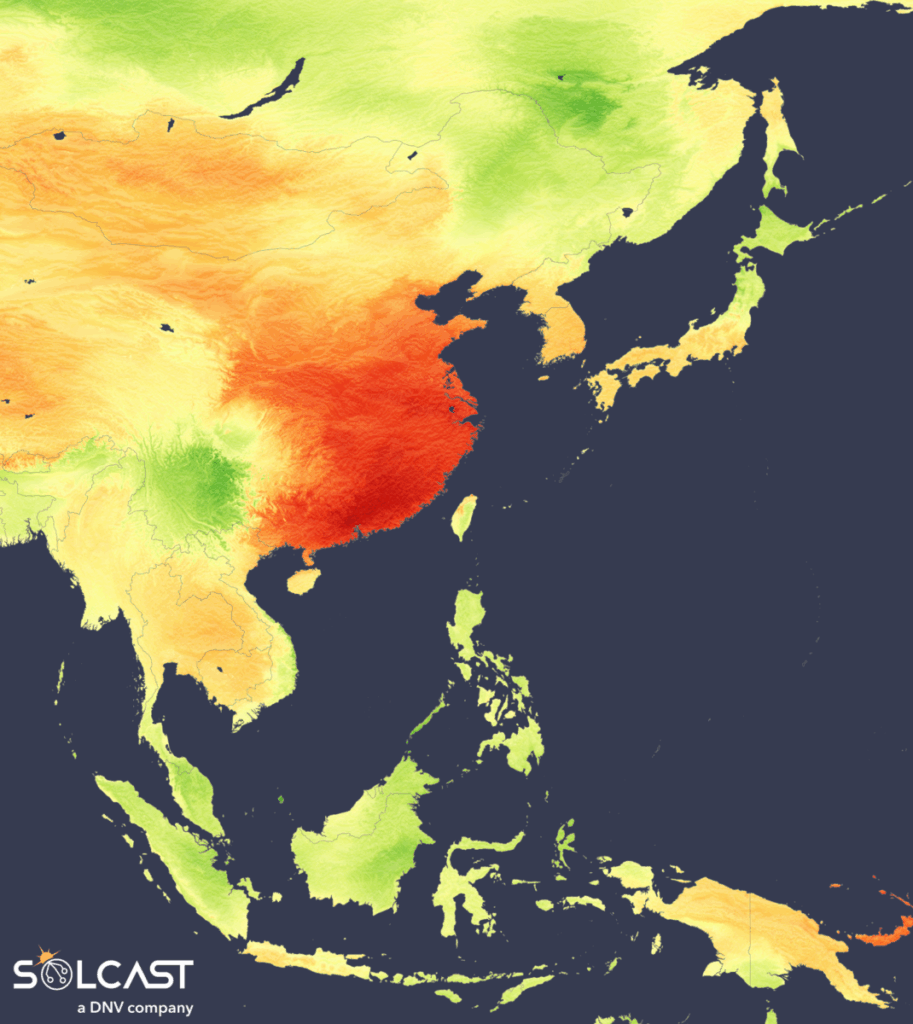In a new weekly update for PV -MagazineSolcast, a DNV company, reports that a significant reduction in pollutants in the air has contributed to the years of irradiation in some parts of China up to 30% higher than the long-term average. South Korea has benefited from a similar pattern, with an increase in irradiation by 10% from January to April compared to the long-term average.
The clear and dry start of Oost -China until 2025 continued until April, so that the strong radiation abnormalities were observed for the first time in January. Solar radiation in the eastern lowlands remains considerably increased, supported by persistently weak trading winds and a remarkable reduction in the atmospheric haze. In some parts of China, these conditions, which follow an exceptional January, have pushed year-to-date radiation into levels of 30% above the long-term average, according to analysis using the Solcast API.
East China saw an extraordinary peak in irradiation at the beginning of the year, with the values of January reaching 60% above the long-term average. While La Niña conditions have contributed to that deviation in the early season, they have since given way to neutral enso conditions. Nevertheless, the trade winds have remained modest, by continuing to limit the inflow of moisture from the Pacific and maintaining a cool, dry pattern over the region. This lack of cloud -forming humidity, in combination with lower than average rainfall and in particular reduced atmospheric aerosols, has kept the skies over the east and central China unusually kept clear.
South Korea has also benefited from these regional weather patterns, with an increase in irradiation by 10% from January to April compared to the long-term average. The Yunnan region in southwestern China, on the other hand, lagged behind its eastern counterparts, with more persistent haze that probably contributes to the irradiation values below the average for the same period.
An important factor behind this trend is the significant reduction of pollutants in the air. From January to April, as measured by aerosol tax, large Chinese cities registered some of their cleanest air in almost two decades. The radiation lost to Aerosols and Haze was at the lowest level since the following solutions followed in 2007, and the second lowest in Guangzhou. The lectures by Shanghai were the fourth cleanest on record, with only the years influenced by Pandemie from 2020-2022. Seoul also saw the lowest levels of pollution in the same period.
This decrease in loading aerosol can be linked to intensified efforts for clean air and pollution reduction in China. In addition to stimulating irradiation, this trend has important implications for precipitation. With fewer aerosols to sow smaller raindrops, recent research suggests that more efficient rainfall processes can occur, increasing the chance of heavier rain showers. Although this dynamic has not yet manifested itself in the current dry season of Oost -China, it can play a more prominent role during the coming summer wet season.
Elsewhere in Asia, radiation conditions have been less consistent. While Japan and a large part of Southeast Asia showed values almost average, Indonesia experienced considerably wetter conditions than normal. With daily rainfall totals on average 8 mm above normal, has suppressed associated cloud of radiation. It is possible that this is associated with remaining effects of the recent La Niña conditions.
Dissolved Produces these figures by following clouds and aerosols with a resolution of 1-2 km worldwide, with the help of satellite data and own Ai/ml -algorithms. This data is used to stimulate radiation models, so Solcast is able to calculate the radiation at high resolution, with a typical distortion of less than 2%, and also cloud-tracking predictions. This data is used by more than 350 companies that manage more than 300 GW of solar assets worldwide.
The views and opinions expressed in this article are the author, and do not necessarily reflect it by PV -Magazine.
This content is protected by copyright and may not be reused. If you want to work with us and reuse part of our content, please contact: editors@pv-magazine.com.
Popular content




